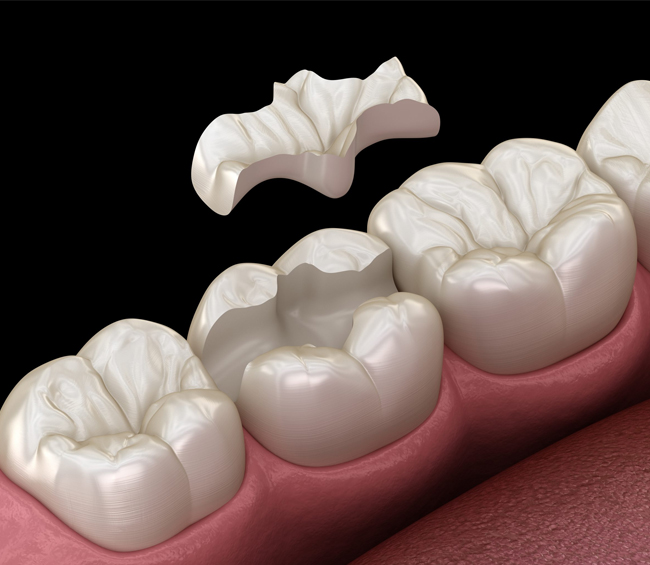
Dental Inlays and Onlays in Albany, OR
If you are concerned about the appearance of your old fillings, new tooth-colored treatments can restore and transform your teeth. Silver and gold fillings are a thing of the past as cosmetic treatments such as inlays and onlays are a new and effective treatment. Inlays and onlays are similar to traditional fillings as they fit inside the tooth where a cavity once was and seal it. The signifying difference is that they come in a variety of tooth-colored materials for an enhanced, more uniform smile.
As most inlay and onlay treatments replace old fillings, the cavity has already been removed and filled. This makes treatment easier, faster, and generally pain-free. Inlays and onlays provide a more sustainable treatment and a natural-looking smile.
Inlays and onlays are available at West Albany Dental in Albany and the surrounding area. Our staff can help you determine whether this treatment is right for you. Call us at (541) 249-7319 to schedule an appointment.
Understanding What Botox Is
Botox is an injectable treatment made from the Botulinum toxin that the bacterium Clostridium botulinum produces. Botox is a neurotoxin that targets the nervous system and disrupts the nerve signaling processes that cause muscle contraction. Without this muscle contraction, the muscles are less stiff. Medical professionals inject the drug into the face to paralyze or weaken the muscles and block nerves.
Although the Botulinum toxin is dangerous by itself, Botox is safe and has few side effects when administered by a professional in a therapeutic context. Manufacturers use small doses of the Botulinum toxin to make Botox before injecting it into the skin to treat various conditions. To administer this treatment, medical professionals dilute the Botulinum toxin powder with saline and inject it into the neuromuscular tissue. This study in the Clinical, Cosmetic and, Investigational Dermatology journal found that the injection can help relax and soften wrinkles and reduce the appearance of fine lines.
Determining Botox Candidacy
Botox is an excellent option for those who want an effective yet minimally invasive cosmetic treatment. This popular treatment has high patient satisfaction rates in improving facial appearance and reducing signs of aging. Botox is low-risk yet effective and does not involve downtime for recovery like cosmetic surgery does.
According to the American Society of Plastic Surgeons , there were 7.23 million Botox procedures performed in 2017. Botox may be the right treatment for patients who first start to notice moderate lines on the face, typically after age 30 or so. However, everyone's facial lines form differently due to a combination of factors, including genetics and the environment. Patients should be healthy and not pregnant or breastfeeding. People with allergies to any of the ingredients, muscle or nerve conditions, or active infections may not be good candidates for this treatment.
Cosmetic and Medical Usage of Botox
Depending on the patient’s needs, Botox can help with either cosmetic or medical purposes. Botox injections are one of the most popular cosmetic procedures in the nation. Injections can reduce wrinkles around the eyes and mouth; on the forehead and chin; and between the eyebrows.
Medical professionals also use Botox to treat some medical conditions. In particular, injections can treat conditions that affect the neuromuscular system. The FDA has approved Botox treatment for conditions like chronic migraines, eyelid spasms, hyperhidrosis, and cervical dystonia.
The Botox Injection Process
Individuals commonly get Botox to target forehead lines, crow's feet, and frown lines around the mouth. During the procedure, the medical practitioner will choose several injection sites on the face to inject using a small needle. Injections take about 15 to 30 minutes to administer in one appointment. Some swelling, redness and bruising are normal after the appointment. Botox treatment requires little recovery, so most patients can return to their regular routine right away.
The study above also found that the results of Botox are quick, with clinical effects appearing one to four days after injection. A few days after the injections, patients can see a smoother facial appearance, and any bruising or swelling should disappear. The results will last three to 12 months, depending on the type of treatment the patient received. Since this is a temporary treatment, Botox® starts to lose effect after four to six months, and wrinkles and fine lines will return. Scheduling top-up appointments at around four months keeps the face looking refreshed.
The Recovery Period
The effects of Botox treatment can last up to 6 months, depending on the patient’s case and maintenance. Although there is no recovery time for Botox treatments and patients may resume normal activities after the procedure, it is a good idea to understand safe practices in order to attain maximum results.
Upon completion of Botox treatment, patients should refrain from rubbing or itching the injected area for at least 4 hours. They should not exercise or move vigorously for 24 hours and keep their head in an upright position for at least the first 4 hours. Individualized instructions will be given to each patient promptly after treatment.



